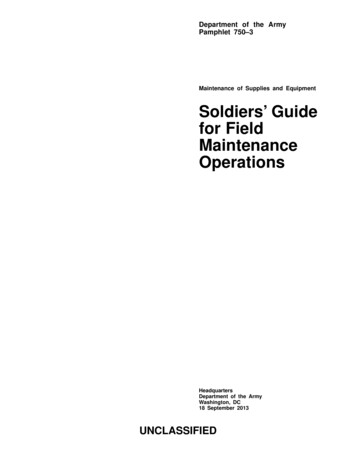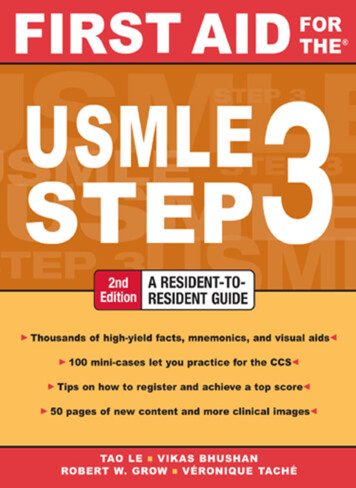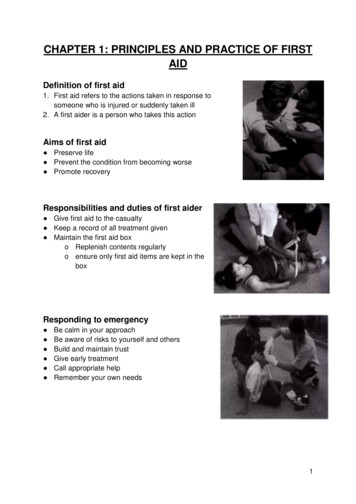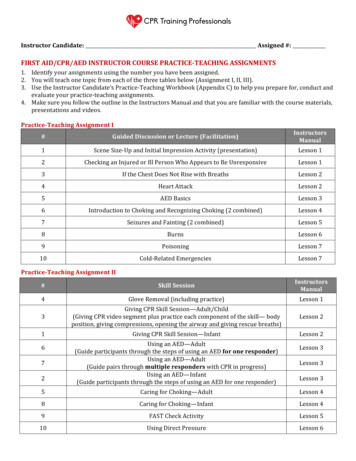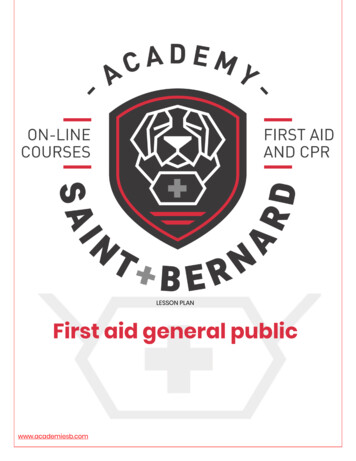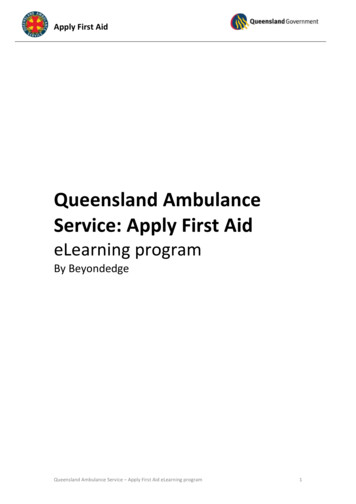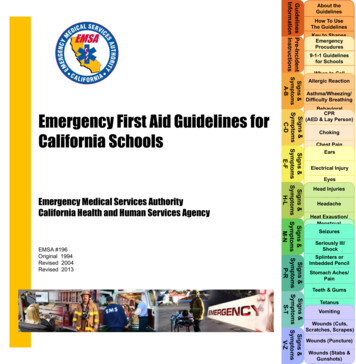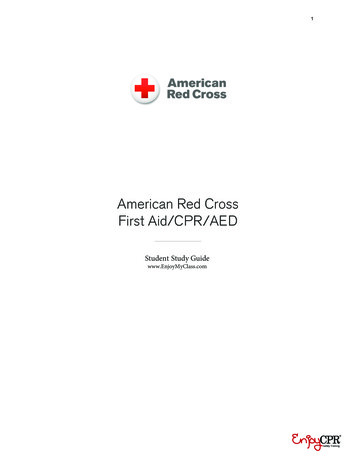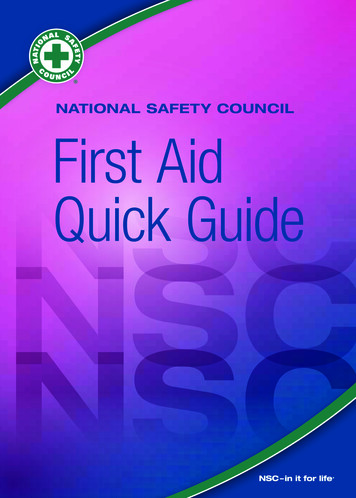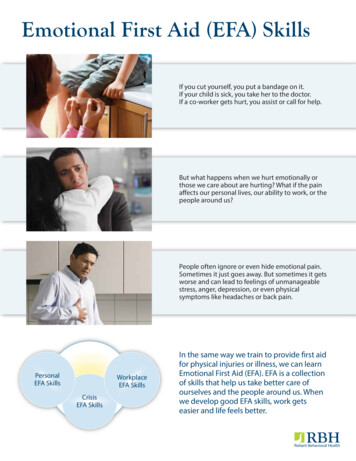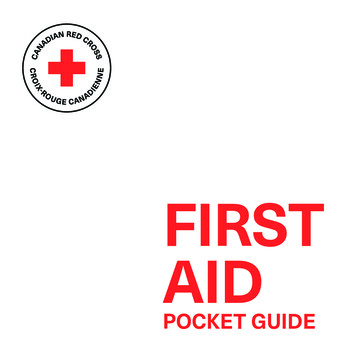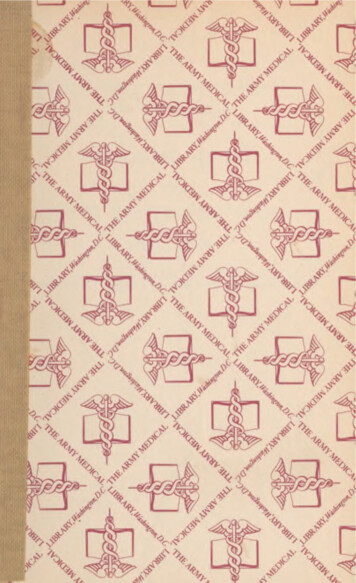
Transcription
PM 21-11WAR DEPARTMENTBASIC FIELD MANUALFIRST AID FOR SOLDIERSApril 7, 1943
FM 21-11BASIC FIELD MANUALFIRST AID FOR SOLDIERSPreparedunder direction oftheCommanding General,ArmyService ForcesUNITED STATESGOVERNMENT PRINTING OFFICEWASHINGTONForsalebytheSuperintendent:1943of Documents, U. S. Government Printing OfficeD. C.Washington,
WAR DEPARTMENT,Washington, April 7, 1943.FM 21-11, Basic Field Manual, First Aid for Soldiers, ispublished for the information and guidance of all concerned.[A. G. 0G2.11(9-15-42).]By order of the Secretary ofWar :G. C. MARSHALL,Chief of Staff.Official :J. A. ULIO,Major General,The Adjutant General.Distribution:X.(For explanationof symbol see FM 21-6.)
TABLE OP CONTENTSParagraphsSection I.II.III.IV.General1-5Wounds6-1314-28Fractures, dislocations, and sprainsCommon emergencies and healthmeasures29-48V. Effects of severe heat, and measuresfor use in the desert49-52VI. Effects of severe cold, and measuresfor use in the Arctic53-58VII. Measures for use in the jungle andTropics59-62VIII. Measures for use in aircraft and tankinjuries63-6465-67IX. Transportation of sick and injuredgases68—69X. WarXI, Descriptionof first-aid kits andpackets70-80XII. Uses of contents of first-aid kits 3
FM 21-11BASIC FIELD MANUALFIRSTAID FOR SOLDIERS(The matter contained herein supersedes chapter 10, PM 21-10;and section 11, chapter 14, FM 21-100.)Section IGENERAL 1.Manual.—The purpose of this manual is toteach the soldier what he can do for himself or a fellowsoldier if injury or sickness occurs when no medical officeror Medical Department soldier is nearby. Information is alsogiven concerning the use of certain supplies which are forthe purpose of helping to keep well. If a soldier does the rightthing, he may save his own or someone else’s life, or at leastrelieve suffering. If he does the wrong thing, he may domore harm than if he does nothing.Purpose of 2. Definition.— First aid means those medical measureswhich a soldier can carry out for himself or a companion anddoes not apply to the emergency medical treatment which isgiven by a medical officer or a Medical Department soldier. 3. Soldier’s Equipmentfor First Aid. Every soldier isissued certain equipment for giving first aid. Besides thesupplies which he carries, other equipment will be found inthe first-aid kits and packets in motor vehicles, airplanes, oramong special troops. Soldiers whose assignments may require them to know how to use special first-aid equipmentcan find descriptions, illustrations, and directions for use ofthese supplies in sections XI and XII. In addition to thefirst-aid supplies mentioned, many objects which are a regular part of every soldier’s clothing and general equipmentor which will be found almost anywhere can be used in givingcertain types of first aid.— 4.Important First-Aid Rules.a. Do not get excited; act quickly but calmly.b. Do not try to do too much.1
4-7BASIC FIELD MANUALc. Handle an injuredperson gently.d. Keep an injured person warm.e. Whenever possible, give an injured person first aidbefore he is moved./. Do not pour liquids into the mouth of an unconsciousperson; to do this may choke him.g. Do not try to bring an unconscious injured person toconsciousness. Let him lie quietly, face down, with his headturned to one side.h. Remember that drugs are dangerous if too much isgiven; follow' directions when using drugs in first-aid kitsand packets.i. Anyone who has been given first aid for a serious condition should be seen as soon as possible by a medical officer. 5. First Aidin Combat.—Successful accomplishment of theassigned mission is the aim of battle. The combat soldierwill administer first aid only when he can do so withoutinterfering with his combat duties. When administration offirst aid in actual combat is possible, usually only thosemeasures will be taken which are immediately necessary tosave life. The wounded person should be placed where heis protected from enemy fire and the elements, marking thespot where he lies so that he can be easily found by MedicalDepartment personnel.Section IIWOUNDS 6. General.—Wounds are the most common conditionswhich require first aid. Prompt and correct first aid forwounds will not only speed their healing, but will oftensave a life. First aid for wounds includes measures to stopbleeding, overcome shock, relieve pain, and prevent infection. 7.Exposure of Wound.—To give proper first aid, the entire wound must be well exposed in order to ascertainexactly where it is, how large it is, and how much it isbleeding. When a wound has been caused by a bullet, ashell fragment, or other object which could have gone allthe way through a part of the body, look for a wound wherethe object may have come out, because the wound where2
FIRSTAIDFOR SOLDIERS7-8it comes out is usually larger than the wound where it goesin. In order to see all wounds which may be present, cut,tear, or remove the clothing as much as necessary. Do notdrag clothes over a wound; carefully lift them off. 8. Bleeding.—All open wounds bleed more or less. Bleeding from an artery is known as arterial bleeding, and bleedingfrom a vein is known as venous bleeding. Bleeding from thearteries is more dangerous because the blood flows fast andwill soon cause a person to bleed to death unless the flowof blood is stopped. In most severe wounds there is bleedingfrom both arteries and veins. Bleeding of any type must bestopped as soon as possible. The first-aid methods to stopbleeding are to press directly over the wound, to elevate thewounded part, or to use a tourniquet.a. Direct pressure over wound. —Direct pressure over thewound should always be tried first. To do this, put a steriledressing, such as the one in your individual first-aid packet.FigureI. —Direct pressure over a wound to stop bleeding.3
8BASICFIELDMANUALover the wound and press firmly on the dressing as shownin figure 1. Keep up the pressure for at least 5 minutes andthen hold the dressing in place by bandaging. (See par.lid.)More than one dressing may be needed for largewounds.b. Elevating wounded part. —Raising a wounded arm or leghigh above the body, as shown in figure 2, will help to stopFigure2.—Elevation of an arm to help stop bleeding.bleeding. The wounded person must lie down and the armor leg must be held up as high as possible while direct pressure is made on the wound and a sterile dressing is put on.c. Use of tourniquet.—(l) Do not use a tourniquet xinlessbleeding cannot be stopped by other means. Bleeding froma wound can usually be stopped by applying a sterile dressing,pressing directly over the wound, and, if possible, raising thewounded part. If a regular issue tourniquet is used, thebuckle should be on the inside of the upper arm or thighas shown in figures 3 and 4, and the strap should be pulled4
FIRST AID FOR SOLDIERS8in a downward direction while the injured part is steadied.If bleeding cannot be stopped by simply pulling the tourniquettight, loosen it enough to slip a bayonet or other object underit so that it can be made tight enough by twisting.(2) For bleeding from the arm and hand, put on thetourniquet about a hand’s breadth below the armpit as shownin Figure 3. For the thigh and leg, put it on about a hand’sbreadth below the crotch as shown in figure 4.Figurp 3.—Application of tourniquet to arm.(3) If a regular tourniquet is not available, a triangularbandage, a tie, a belt, or a handkerchief will do instead.Figure 5 shows how a tourniquet is tightened by twisting itwith a bayonet or a stick.(4) Tighten a tourniquet only as much as is necessary tostop bleeding.(5) A properly applied tourniquet stops all the blood goingto the injured part, and gangrene may develop if a tourniquetis left on too long. It should be loosened every 20 or 30minutes, and then tightened again after 10 or 15 seconds.(6) Do not cover a tourniquet with a bandage or a splintbecause, if covered, it may be forgotten and left on too long.5
8BASICFigureFIELDMANUAL4.—Application of tourniquet to leg.Figure5. —An improvised tourniquet.6
FIRSTAIDFOR SOLDIERS8-9If you put a tourniquet on a wounded person who is consciousand then leave him, tell him to be sure to get someone toloosen it for at least 10 or 15 seconds every 20 or 30 minutes. 9. Shock. a. Shock is a condition of weakness whichusually follows wounds, burns, or other injuries. When severe shock has developed, the injured person is pale, and his—skin is cold and wet with sweat. Remember, however, thatthese are signs of severe and fully developed shock. A personwho is suffering from a mild degree of shock may not showthese signs. First-aid measures for shock should, wheneverpossible, be started before the injured person has developeddefinite signs of shock. Shock is especially likely to occur ifa person is bleeding. Shock can also be caused or increasedby exposure to cold, fatigue, or hunger. A certain amountof shock follows all injuries and burns; it may be slight andlast only for a few minutes, or it may be severe and last for along time, and may even cause death. As a rule, the moresevere an injury or burn, the greater will be the amount ofshock. Shock often does not appear until many minutes oreven several hours after a wound, burn, or other injury. Evenbefore shock can be noticed, take measures to prevent it.b. Handle the injured person gently, avoid unnecessarymoving of the injured part or of the injured person, and in allother ways make him as comfortable as possible.c. To prevent or overcome shock, put the injured personon his back with his head and shoulders lower than his legsand hips. If he is unconscious, keep him face down, withhis head turned to one side, and with his head and shoulderslower than his legs and hips.d. Stop any bleeding as soon as possible.e. Remove the individual’s pack and loosen tight clothingor straps. v/. Keep an injured person warm, but be sure not to overheat him because overheating can increase shock instead ofpreventing or overcoming it. Ordinarily, simply cover himwith extra clothing or blankets. If the weather is cold, applyheat by means of bottles or canteens filled with hot water, orby means of warm stones or bricks. These warm objects canbe placed between the legs, under the armpits, and beside thewaist; they should be covered or placed between blankets and7
9-11BASICFIELDMANUALshould not be put against bare skin or against very thinclothmg because they may burn the person.g. Warm drinks are helpful in shock. If a person has awound of the abdomen or throat, never give him more than afew small sips of water to wet his lips. Unless very thirsty,a person with a wound of the abdomen or throat should begiven nothing to drink, and should never be given anythingto eat. 10. Pain.— Some pain occurs sooner or later following allwounds. Pain is often so slight that it does not bother theinjured person enough to require any particular attentionbut, if pain is severe, it must be relieved as much as possible.Pain can often be prevented or relieved by simple measuressuch as keeping an injured person quiet and warm, carefullychanging his position to make him comfortable, splintingan injured arm or leg, and gentle handling during transportation, Only when pain is severe, or when a badly injuredperson must be moved quickly, as from a wrecked vehicle oraircraft, is it wise to give him morphine. If pain is severe,however, a dose of morphine will not only relieve the pain butwill also lessen shock. If morphine is needed to relieve pain,it will be found in certain first-aid kits and packets, alreadyprepared for injection, in a collapsible tube with an attachedneedle. Directions for its use are given in paragraph 110 andare shown in figures 96 and 97.Caution: The full effects of morphine are not felt for20 to 30 minutes after injection. A second injection of morphine for continued severe pain should not be given soonerthan 2 hours after the first one. Never give a second doseof morphine to a person who is breathing 12 or less times aminute. Never give morphine to an unconscious person. 11. Infection.— a. Whenever the skin is torn or cut, infection may occur. Infection is very likely to take place if awound touches the ground, or if anything else dirty touchesor gets into it. A wound which becomes infected is muchmore serious than one which is kept clean, so the preventionof infection is a very important first-aid measure. At thesame time that bleeding is being stopped and a dressing applied, as well as after these first-aid measures have been8
FIRST AID FOR SOLDIERS11carried out, care must be taken to keep a wound clean, soas to prevent infection.b. Do not touch a wound with dirty hands or dirty clothing.Do not allow a wound to touch the ground. Do not wash awound.Figure6. —Fix-st-aid packet being opened by pulling on metal tapewhich seals the container.c. If there is only a small amount of bleeding from a woundwhen first seen, or if bleeding has been easily stopped, sprinklesulfanilamide, which is in the first-aid packet (figs. 6 and 7),into the wound as shown in figure 8, and then apply the steriledressing, which is also in the first-aid packet. When bleedinghas been hard to stop, do not lift up or take off the dressingto sprinkle sulfanilamide into the wound; removing the dressing may start bleeding again.d. The proper application of a sterile dressing is an important means of preventing infection as well as of stoppingbleeding. To use the dressing in the first-aid packet, carefully remove the wrapper as shown in figure 9. Open the9
BASIC FIELD, MANUAL11FigureFigure7. —Contents of first-aid packet.8. —Sprinkling sulfanilamide into a wound.10
FIRST AID FOR SOLDIERSFigure9. —Removal of wrapper from dressing.Figure10. —Method of opening compress.1111
11BASIC FIELDMANUALcompress by pulling on the two folded bandages attachedto the compress, as shown In figure 10, being careful not totouch the inside of the compress with the fingers or anythingelse. Still holding one folded bandage in each hand, applythe compress to the wound as shown in figure 11; then wrapthe bandage around the injured part of the body and tie theends together or fasten them with safety pins.Figure11.—Application of dressing to wound.e. When wounded other than in the abdomen or throat,take by mouth, along with a large amount of water, the eightsulfadiazine tablets (or the twelve sulfanilamide tabletsfound in some packets instead of sulfadiazine tablets) whichare in the sealed packet carried in the first-aid pouch attached to the cartridge belt. If sweating has been great orif large amounts of water cannot be taken both with thedrug and for 24 hours afterward, no sulfadiazine or sulfanilamide tablets are to be taken.12
12-14FIRST AID FOR SOLDIERS 12.Splinting of Injured Arm or Leg.—A severely woundedor leg should, if possible, be splinted (par. 17) or placedin a sling after dressings have been applied, even if no boneis broken; this will keep the injured part at rest and will helpto prevent bleeding, to lessen shock, to relieve pain, and toarmprevent infection. 13. WoundsRequiringSpecialAttention.a. Wounds—extending into the chest. —lf there is a wound of the chestthrough which air is sucking in and blowing out, the life ofthe person may depend upon quickly applying a dressingwhich is large enough to cover the wound and which completely stops the flow of air through the wound. If this doesnot stop the back and forth movement of air, apply moredressing. A large piece of raincoat, overcoat, blouse or shirtapplied tightly over the dressing may be useful in makingthe dressing airtight. A person with a wound of the chestwill be more comfortable and breathe more easily if he lieson the injured side.b. Wounds entering the abdomen. —lf a bullet or otherobject has gone into or through the abdomen, the injuredperson should be given nothing to eat or drink. Under nocircumstances give anything more than a few small sips ofwater to wet his lips. If the abdominal organs have comethrough the wound do not try to put them back. Sprinklesulfanilamide over the wound and organs, and put on alarge sterile dressing.c. Wounds of the jaws, mouth, and face.—If there is awound of these parts, the face of the wounded person shouldbe kept pointed toward the ground in order to prevent bloodfrom getting into the back of the throat where it may causechoking. Until bleeding stops, keep the person in a sittingposition with his head bent forward. If it is necessary forhim to lie down, or if he must be carried on a litter, keep hisface pointed to the ground.Section inFRACTURES, DISLOCATIONS, AND SPRAINS 14. Types of Fractures. A simple fracture is a breakin a bone. A compound fracture is one in which there is—a flesh wound which extends through the skin and down515790 —432
14-17BASICFIELDMANUALto the broken bone. The flesh wounds in compound fractures are usually caused by the sharp ends of the brokenbone or by bullets or fragments of high explosive shells,grenades, or bombs. Compound fractures are more seriousthan simple fractures because of the danger of infectionin the flesh wound and because shock is usually greater.Careless handling of a simple fracture may cause it tobecome a compound fracture.SS 15. Signs and Symptoms of Fracture. —One or more ofthe following signs or symptoms may be present when thereis a fracture:a. Pain and tenderness near the fracture.b. Partial or complete loss of ability of the injured personto move the part.c. Deformity (unnatural shape).d. Swelling.e. Discoloration (blueness about the point of injury).f. Grating of bone ends may be felt, but no attempt shouldbe made to produce this. 16. First Aidfor Fractures. a. Handle all persons withfractures, or even suspected fractures, with the greatestgentleness; rough or careless handling causes pain and shock.Immediate transportation of a person with a serious fracture is sometimes harmful even if done very carefully:this is especially true of fractures of the thigh, hip, leg, orback, and in all cases in which shock has already appeared.Give first aid, including splinting of the fracture, where theinjured person is lying.b. Straighten the limb by pulling gently but steadily uponits lower end.c. Keep up this steady pull and support the limb oneither side of the fracture until a splint is applied. 17.—Splints. a. A splint should be as wide as the limband long enough to prevent movement of the next joint ineither direction from the fracture. Temporary splints canbe made from many common materials such as shingles,pieces of board, bayonet scabbards, pieces of tin, wire mesh,and folded blankets. Pad splints well on the side towardthe skin and bind them securely in place at several points—14
FIRST AID FOR SOLDIERS17-18above and below the fracture but not over the fracture.b. Be sure that bandages are not so tightly bound as tostop the circulation of blood when swelling of the limboccurs, as it usually does after a fracture. Swelling, coldness, stiffness, blueness, or numbness of a foot or hand isoften due to too tight bandaging. If any of these signs arenoticed, loosen the bandages which hold on the splints butdo not remove them. 18.Slings. —ln fractures or other severe injuries of thearm or shoulder, the arm should usually be supported bya sling, in addition to the use of splints or other first-aidmeasures. A triangular bandage (pars. 72 and 73 makesa very good sling (figs. 12, 13, 14, and 15), but arm slingsmay be made from ordinary bandages, clothing, or by usingsafety pins to fasten the coat or shirt sleeve to the front ofthe coat or shirt. The coat flap or shirt tail may be usedas a sling by pinning it to the coat or shirt or by punchinga hole through the lower edge of the flap or tail and buttoningthis to one of the upper coat or shirt buttons. Varioustypes of slings are shown in figures 12 to 18, inclusive.Figure12.—Triangular bandage.15
18BASICFigureFIELD MANUAL13.—Sling made with triangular bandage—first step.16
FIRSTFigureAIDFORSOLDIERS14.—Sling made with triangular bandage—second step.1718
18BASIC FIELDFigureMANUAL15,—Sling made with triangular bandage—completed.18
FIRSTFigureAIDFOR SOLDIERS16.—Sling made with shirt tail.1918
18BASIC FIELD MANUALFigure17.—Sling made with coat flap.20
FIRST AIDFigure 18.—SlingFORSOLDIERSmade with shirt sleeve.2118
19-21BASIC FIELDMANUAL 19. Fractures With Flesh Wounds (Compound Fracln fractures with flesh wounds, both the fleshtures)—.wound and the fracture require first-aid measures. Stopbleeding, sprinkle sulfanilamide into the wuund, and bandagewith a sterile dressing. If the bone is sticking through theskin, do not push it back. Straighten the injured part bygently pulling upon it, and apply a splint. 20. twoone on the inner side from the armpit to the elbow19.—Splints and sling for fracture of arm above the elbow.and another on the outer side from the shoulder to the elbowas shown in figure 19. Support the forearm and hand witha, sling.If no bettermeans are at hand for splinting a broken arm,bind it to the body, keeping the forearm bent at the elbow,with the hand near the opposite shoulder, as shown in figure20. 21. Fractures at or Near the Elbow.—Place the forearmand hand in a sling which also covers the lower part of the22
FIRSTAID FORSOLDIERS21-22arm as shown in figure 15. If the elbow cannot bebent because of pain or swelling, apply a single straight splintextending from the upper part of the upper arm to the palmof the hand, as shown in figure 21.upperFigure20.—Upper arm bound to body as a means of splinting. 22. Fractures of Arm Below the Elbow (Forearm).—With the arm bent half way at the elbow, apply a splint tothe inner surface, extending to the tips of the fingers andanother to the outer surface, also extending to the fingertips, as shown in figure 22.23
22FigureBASIC FIELD MANUAL21. —Straight splint for fractures at or near the elbow (whenthe elbow cannot be easily bent).Figure22.—Splint for fracture of forearm.24
FIRST AID FOR SOLDIERS23-25 23. Fractures of Collar Bone.—Bend the forearm to aright angle in front of the body and place it in a sling asshown in figure 15. 24. Fractures of Leg, Knee, or Ankle.—Apply two splints,one on the outside, the other on the inside of the limb, extending from above the knee to beyond the foot. Supportcan be given by a splint made of two sticks padded withFigure23.—Splint for fracture of leg, knee, or ankle—intermediatestep.clothing or a blanket, as shown in figures 23 and 24. Apiece of tin, molded in the form of a gutter, makes a verygood splint for leg fractures. If there are no other meansof splinting a broken leg, pad it well and bind it to the otherleg. In snow country, skis may be used as splints.of Thigh or Hip.—lt is especially importantto apply a splint before moving persons with such fractures.Apply a long splint, reaching from the armpit to beyond 25. Fracturesthe foot on the outside, and another from the crotch to the25
25FigureBASICFIELDMANUAL24.— Splint for fracture of leg, knee, or ankle—final step.Figure25.—Splint for fracture of thigh or hip.26
FIRST AXE FOR SOLDIERS25-27foot on the inside, as shown in figure 25. A blanket rolledinto two rolls to form a trough will help to keep a brokenleg steady. If there is no other means of splinting a brokenthigh, bind the injured leg to the well leg. If an injuredperson with a fracture of the leg must be moved beforea splint can be applied, carry him as gently as possible, supporting the injured limb above and below the fracture andkeeping it straight as shown in figure 26.Figure 26.—Supportabove and below fracture of right lower legnear knee. 26. Fracturesof the Jaw.—For a simple fracture of thejaw, apply a bandage which extends under the jaw and overthe top of the head, holding the teeth closed; this will support the jaw and keep it at rest. For a compound fractureof the jaw, with bleeding into the mouth, apply a dressingwhich covers the flesh wound but which will not keep thewounded person fromspittingout the blood. 27. Fractures of Spine (Neck or Back) .—lt is often impossible to be sure that there is or is not a fracture of thespine. Whenever a person has been in an accident in whichhis back may have been sharply bent or struck, keep in mind27
27BASICFIELDMANUALthat either his neck or back may have been fractured. Painin the back or neck, loss of power to move all or part of anarm or leg, or lack of feeling in an arm or leg, may follow afracture of the spine, but one or more of these symptomsmay be absent. If a broken neck or back is suspected, theinjured person’s head should not be lifted even to drinkwater. Do not let the injured person try to stand or sit up.Very gently straighten him out and roll (do not lift) him ontohis back, being careful not to bend or twist his neck or back.Figure27.—Person with a fracture of the spine being rolled onto alitter.Unless it is absolutely necessary to do otherwise, leave totrained Medical Department personnel the transportationof a person who has an injured back. If, however, it isnecessary to move a person who has such an injury, he shouldbe rolled in the same careful way when being moved ontoa litter (see par. 65) as shown in figure 27. Put a roll of clothing or blanket about 4 inches thick under the small of hisback, as shown in figure 28. If it is thought a person mayhave a broken neck, keep his head from rolling from side to28
FIRST AID FOR SOLDIERSFigure2728.—Support of fractured spine by means of a roll under theback.Figure29. —Support of head of person with fractured neck.515790 —43329
27-29BASIC FIELD MANUALside by placing something such as blanket rolls, folded clothes,or stones on each side of his head to steady it as shown infigure 29. When the combat situation permits, three or morepersons should help in moving anyone who has a fractureof the back or neck; one person should support the buttocksand legs, a second person should support the chest andshoulders, and a third person should support the head to prevent bending or twisting of the neck. Unless a person withan injured back can be moved with the care outlined abovehe should not be moved until medical personnel arrives. 28. Dislocationsand Sprains. —Whena bone gets out ofplace at a joint, the condition is called a dislocation. Whenthe ligaments around a joint are torn or bruised, the conditionis called a sprain. In both these conditions pain is usuallysevere, and shock may be present. It is often impossible totell the difference between a sprain, a dislocation, and a fracture; when this is the case, the first aid given should be thesame as for a fracture.a. First aid for dislocations. —(l) If the injury is to theshoulder, elbow, wrist or hand, place the arm in a sling.(2) If the injury is to the hip, knee, ankle or foot, splint thelimb and give the same care as for fractures in these parts ofthe body.b. First aid for sprains (strains). —(l) In severe sprainsof the shoulder, elbow, wrist, and hand, place the arm in asling. For a sprain of the wrist, firm bandaging will giverelief.(2) In severe sprains of the hip, knee, ankle, or foot, it issometimes necessary to apply a splint just as for a fracture ofthese parts. Firmly bandaging an ankle sprain sometimesgives relief and makes it possible to walk without much pain.Section IVCOMMON EMERGENCIES AND HEALTH MEASURES 29. Snake Bite.— a. Snake venom acts rapidly, so first aidmust be given quickly to prevent the poison from beingspread throughout the body.b. When a snake bite is on an arm or leg put on a tourniquet at once, placing it between the trunk of the body and the30
FIRSTAID FOR SOLDIERS29bite. Apply the tourniquet above the knee, in foot and legbites; above the elbow, in hand and arm bites. A necktie,belt, handkerchief, or triangular bandage can be used as atourniquet. The tourniquet should be loosened every 20 to 30minutes for 10 or 15 seconds.c. Apply iodine to the area around the bite.d. Paint with iodine, either the lancet in the snake-bite kit(figs. 30 and 31), the blade of a pocket knife, or a razor blade.Figure30.—Snake-bite kit—outside view.e. Make cross incisions Vi-inch long and Vi-inch deep overeach fang mark (fig. 32)./. Apply suction to the wound for 20 minutes before loosening tourniquet. Keep up suction for at least three 20-minuteperiods. This can be done by mouth (fig. 33), if a snake bitekit is not handy; snake venom is harmless in the mouthunless there are cuts or sores. If a snake-bite kit is available,use the small oval cup for making suction on fingers andtoes; for flatter surfaces use the round cup (fig. 34). Pressthe cup tightly over the incisions and press and release theplunger to produce suction. Suction may be increased byrepeating this movement (figs. 34 and 35).31
29BASIC FIELD MANUALkit— cone3Ss.a1-b'Figure32
FIRST AID FOR SOLDIERSFigure32. —Cross incisions through snake-bite fang-marksFigure33. —Suction by mouth for snake bite.3329
29BASIC FIELD MANUALFigureFigure34.—Suction with suction apparatus for snake biteplunger down—35. —Suction with suction apparatus for snake biteplunger released.34—
FIRST AID FOR SOLDIERSFigure2936 —Sprinkling sulfanilamide into incision after suction forsnake bite.Figure 37.—Application of dressing35over incisions for snake bite.
29-31BASIC FIELDMANUALg. If the breathing of a person who has been bitten by asnake becomes difficult or shows signs of stopping, giveartificial respiration as shown in figures 47 and 48.h. If there is a great amount of bleeding from the incisions,place a gauze compress on the wound and press the thumbor one or more fingers firmly over the incisions.i. After the last period of suction has been completed, remove the torniquet; sprinkle sulfanilamide into the incisions(fig. 36); and apply
1 FM 21-11 BASIC FIELD MANUAL FIRST AID FOR SOLDIERS (The matter containedhereinsupersedes chapter 10, PM 21-10; andsection 11,chapter 14, FM21-100.) Section I GENERAL 1. PurposeofManual.—The purpose of thismanual is to teach the soldier what he can do for himself or a fellow soldier ifinj
